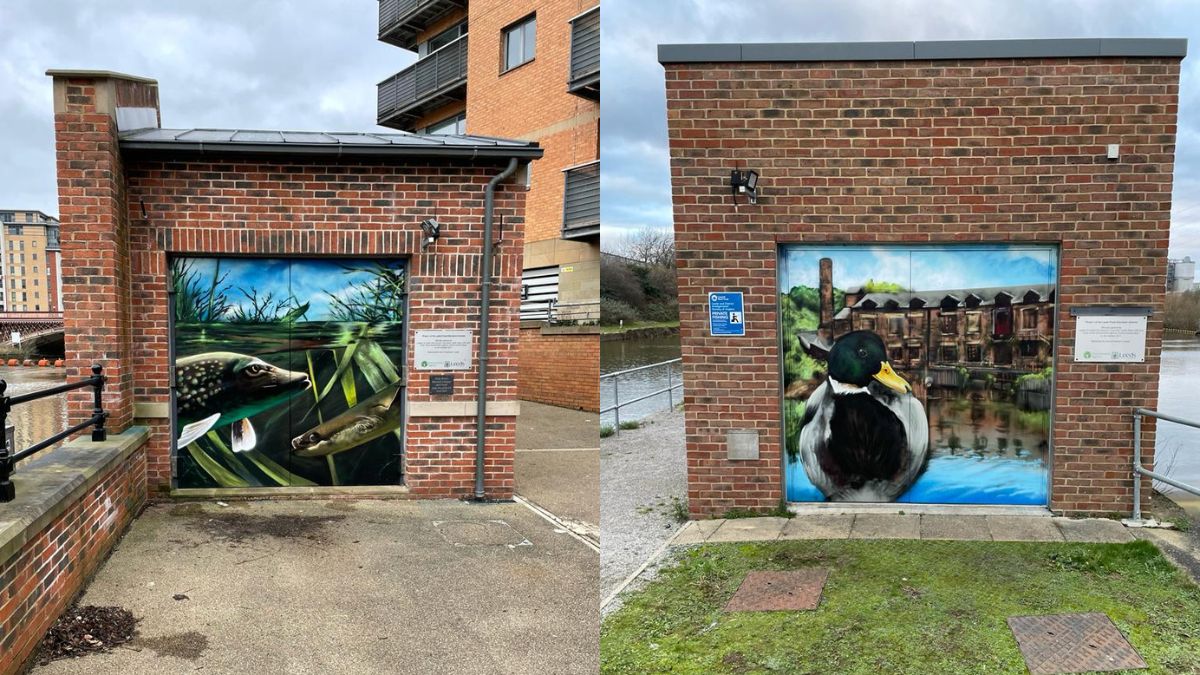The new murals in Leeds’ Flood Alleviation Scheme celebrate the city’s heritage and wildlife while also deterring vandalism. Commissioned artist James Mayle’s creations reduce maintenance costs and contribute to community enhancement through the Leeds Street Art Trail.
What is the purpose of the new murals in Leeds’ Flood Alleviation Scheme?
The new murals in Leeds’ Flood Alleviation Scheme serve a dual purpose: they celebrate the city’s industrial heritage and wildlife, and act as a deterrent against vandalism on flood defence control rooms. Commissioned artist James Mayle’s creations blend aesthetic improvement with crime prevention, reducing maintenance costs and contributing to community enhancement through the Leeds Street Art Trail.
Leeds Flood Alleviation Scheme: A Fusion of Functionality and Art
Leeds, known for its rich industrial legacy and vibrant city life, has recently taken an innovative approach to intertwine its cultural heritage with modern flood defence mechanisms. The Leeds Flood Alleviation Scheme, a pioneering initiative launched in 2017, has been crucial in safeguarding the city’s economy and homes. The scheme includes cutting-edge moveable weirs, located at Crown Point and Knostrop, which have been instrumental during flood threats. Operated from control rooms, these weirs have been successfully activated nine times to date.
The control rooms, however, have been the target of recurrent vandalism. To combat this, Leeds City Council, supported by the UK Shared Prosperity Fund, has taken a distinctive step. Artist James Mayle has been commissioned to create murals on the doors of the control buildings. This merge of utility and creativity not only enhances the visual appeal but also serves as a preventive measure against vandalism.
The Artistic Portrayal of History and Nature
The murals by James Mayle are an ode to both the historical and natural elements of Leeds. They depict scenes of the city’s historic mills, once the heart of industrial Leeds, evoking a sense of nostalgia and remembrance. The artist’s canvas also captures the essence of the local wildlife inhabiting the river, such as ducks, pike, and eels. These species, often overlooked, have been thoughtfully included in the city’s flood defence design, with features like fish and eel passes ensuring their protection.
Councillor Helen Hayden, Executive Member for Sustainable Development and Infrastructure, emphasized the murals’ significance, stating, “These murals showcase how we can work creatively to deter vandals from leaving anti-social graffiti around our city. By supporting artists to create stunning work like this, we brighten up previously unremarkable spaces, we shine a light on an important flood scheme that protects us, as well as including a nod to our city’s past and the animals that also call it home.”
The artwork is not merely decorative; it’s a strategic addition to the cityscape. It’s expected to reduce the maintenance burden that vandalism imposes, allowing resources to be redirected towards further community enhancements.
The Leeds Street Art Trail and Community Impact
The creative initiative taken by the Leeds City Council has broader implications for the city’s cultural landscape. These murals are now a part of the Leeds Street Art Trail, an informal collection of urban artworks that add vibrancy to the city and foster a sense of community. Residents exploring the Knostrop area can enjoy these new additions along the maintained towpaths, which are a part of the flood alleviation scheme’s legacy.
The integration of art into public infrastructure projects like the Leeds Flood Alleviation Scheme is a testament to the city’s commitment to aesthetic improvement and crime prevention. Councillor Hayden shares her anticipation, “The murals can be considered a part of the Leeds Street Art Trail – any residents who make the trip out to Knostrop could use the towpaths that were maintained as part of the Leeds Flood Alleviation scheme – I look forward to going to see them for myself.”
This innovative approach reflects a growing trend where urban art serves a dual purpose: enhancing community spaces and protecting urban infrastructure. It’s a creative solution that resonates well with the public, offering both a visual treat and a layer of protection to essential city assets.
- The new murals in Leeds’ Flood Alleviation Scheme celebrate the city’s industrial heritage and wildlife while also deterring vandalism.
- The murals are commissioned artist James Mayle’s creations, which reduce maintenance costs and contribute to community enhancement through the Leeds Street Art Trail.
- The murals depict scenes of Leeds’ historic mills and local wildlife, such as ducks, pike, and eels, that inhabit the river.
- The integration of art into the flood alleviation scheme is part of the Leeds Street Art Trail, adding vibrancy to the city and fostering a sense of community.
- The murals not only enhance the visual appeal but also serve as a preventive measure against vandalism, reducing the maintenance burden and allowing resources to be redirected towards further community enhancements.
